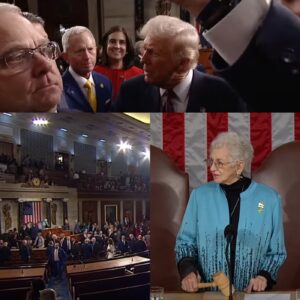President Zelenskyy’s letter will be addressed shortly, but first, let’s discuss the speech that took center stage. This address was the longest ever delivered to a joint session of Congress, surpassing the previous record held by Bill Clinton.

One commentator described it as the most animated, partisan, and lengthy speech they had ever witnessed in such a setting, spanning a career of over five decades. Despite its polarizing nature, they believed it was also one of the most effective speeches given in recent history. The address underscored Donald Trump’s dominance in the political landscape, presenting him as a towering figure of the era. Throughout the speech, Trump recognized and honored various individuals in the gallery, celebrating their stories. However, the Democratic members of Congress often remained seated and appeared visibly unenthusiastic, which some perceived as a poor optic.
An attempt by Representative Al Green to disrupt the speech further contributed to the perception that the Democrats were struggling to respond effectively. The interruption was widely regarded as a misstep, detracting from the party’s message. The President’s approach resonated strongly, making it one of the most powerful speeches of his political career.
At one point, Representative Marjorie Taylor Greene was seen wearing a hat with the phrase “Trump was right about everything.” The Democrats, in contrast, were criticized for failing to unite even in moments that should have been universally celebrated. Some commentators noted that rather than engaging in meaningful discourse, certain Democrats chose to leave the chamber to record social media videos, further reinforcing the perception of division within their ranks. One analyst harshly criticized the party, stating that they lacked common sense, ideas, and heart. Their failure to stand for some of the most inspirational moments of the speech was particularly glaring.
Throughout the address, Trump highlighted various accomplishments and policy proposals, including tributes to fallen police officers and other Americans who had made significant sacrifices. His speech evoked memories of similar past tributes, such as those witnessed at events in Milwaukee, where everyday heroes were celebrated. Unlike traditional political rhetoric, he sought to unite the country through personal stories rather than broad ideological appeals.
Economically, the President emphasized his commitment to tax cuts, vowing to make them retroactive to the beginning of the year. He portrayed these measures as essential to fostering investment and growth. Additionally, he championed policies such as increased domestic drilling and energy independence, which he referred to as “liquid gold.”
While tariffs were a contentious subject, Trump reassured his audience that any economic disruptions would be minor and manageable. His speech presented an overwhelmingly optimistic vision of America’s future, rooted in economic expansion, tax relief, and deregulation. Whether or not one agrees with his policies, his speech conveyed a confident and ambitious outlook for the nation.
Ultimately, the address was a striking display of Trump’s political style—bold, assertive, and aimed at rallying his base while challenging his opposition. The reaction from both parties underscored the deep divisions in American politics, with supporters praising his vision and opponents struggling to formulate a unified response.
News
Alex Hugo : un départ inattendu pour Samuel le Bihan après un changement radical sur France 3 -TB
Capture France 2 A l’aube d’une fin historique, actée par Lionnel Astier, Samuel Le Bilan prendra un nouveau départ…
Samuel Le Bihan : l’homme à la force tranquille -TB
À 57 ans, Samuel Le Bihan a connu le haut de l’affiche avant d’être délaissé par le monde du cinéma….
Alex Hugo : quand seront diffusés les prochains épisodes inédits ? -TB
La popularité d’Alex Hugo, la fiction policière portée par Samuel Le Bihan, ne se se dément pas. Bonne nouvelle pour…
Entretien exclusif avec Samuel Le Bihan pour le retour d’Alex Hugo sur France 3 -TB
La semaine dernière, nous vous partagions la première partie de notre entretien avec Samuel Le Bihan pour la reprise d’Alex Hugo sur France…
Sophie Marceau (57 ans) balance sur sa sexualité : “C’est compliqué… -TB
Sophie Marceau, actrice emblématique du cinéma français, n’est jamais avare en confidences en interview. Elle parle aussi régulièrement de son…
«Star Academy»: retrouvailles en musique avec Nolwenn Leroy et Emma Daumas dans l’émission «Chemins de traverse» (vidéo) -TB
Plus de 20 ans après leur participation au télécrochet, les deux chanteuses ont repris « Évidemment » de France Gall….
End of content
No more pages to load












